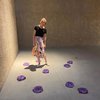This project creates a GPS shield for a Feather board, or more commonly known as a Featherwing. It uses the high-precision ZED-F9P GPS module from u-blox.
The desired Feather board is placed onto the GPS Featherwing and the desired connections are made to enable communication. The Featherwing has a micro-USB port that allows the GPS module to directly communicate with u-center, the u-blox GNSS evaluation software for Windows. The GPS module has two UART, one SPI, and one I2C comms. Jumper pads on the bottom of the Featherwing control what methods the GPS uses to talk with the attached Feather. Pinouts allow the user to choose what pin they want to use for SPI communication. The GPS module can be configured with the Feather using the Sparkfun GPS Library.
The GPS module supports multi-band GNSS antennas. An external antenna is required!
LED indicators tell you the status of the board: power, pulse per second (PPS), RTK status, and geo-fence status. Power LED indicates that the board has power. The PPS LED will blink once a second to indicate that the GPS is talking to satellites. The RTK LED indicates the RTK status of the module. The LED will be off when the GPS is in normal fix mode, blinking with it receiving RTCM correction messages or is in RTK float mode, and will be solid when in RTK fix mode. The Geo-fence LED will indicate if the GPS is in the designated geographical area.
The module is supported by battery backed RAM, which allows the GPS to remember it's previous location and have a faster time to fix.
 sirmylesavery
sirmylesavery

Okee dokee! Thanks for the swift reply. If only I had access to Eagle.
I'm mostly concerned about the microstrip calculation for RF impedance + all the via placement @ getting the groundplane all correct. I haven't been worry about RF impedance stuff on my PCB so this is novel to me and I see why a breakout board for this is nice...
I also understand why so many LORA boards are on their own little boards.